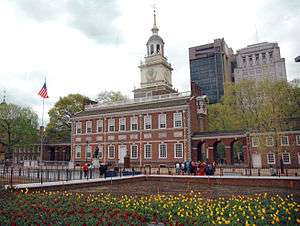Galloway's Plan of Union
| This article is part of a series on the |
| United States Continental Congress |
|---|
 |
| 1st Continental Congress |
| 2nd Continental Congress |
| Congress of the Confederation |
| Members |
|
|
Galloway's Plan of Union was put forward in the First Continental Congress of 1774 but was rejected. Joseph Galloway was a Pennsylvania delegate who wanted to keep the Thirteen Colonies in the British Empire.
Outline of Galloway's Plan of Unions
Galloway suggested the creation of an American colonial parliament to act together with the Parliament of Great Britain. On matters relating to the colonies each body would have a veto over the other's decisions.
The Colonial Parliament would consist of a President-General appointed by the Crown, and delegates appointed by the colonial assemblies. Galloway's plan would have kept the British Empire together, while allowing the colonies to have some say over their own affairs, including the inflammatory issue of taxation.[1]
Galloway's plan was not accepted by the Congress. The appearance of the Suffolk Resolves at the Congress led to a polarization of discussion, with the radicals swiftly gaining the upper hand.[1] Galloway's Plan of Union was narrowly defeated by a vote of six to five on October 27, 1774.
The Galloway and Albany Plans
The proposed Galloway Plan bore striking resemblance to the Albany Plan,[2] a proposal by Galloway's fellow Pennsylvania delegate (and active correspondent) Benjamin Franklin at the Albany Congress in July 1754 to create a unified government for the Thirteen Colonies. The Albany Plan went beyond the original scope of the Albany Congress, which was to develop a plan of defense for the French and Indian War.
Galloway after his Plan of Union's defeat
Although as a delegate to the Continental Congress Galloway was a moderate, when his Plan of Union was rejected, Galloway moved increasingly towards Loyalism. After 1778 he lived in Britain, where he acted as a leader of the Loyalist movement and an advisor to the government. Once Britain's Parliament granted American independence as part of the Peace of Paris (1783), many Loyalists went into forced exile and Galloway permanently settled in Britain.
References
- 1 2 Kindig, Thomas E. (1995). "Galloway's Plan for the Union of Great Britain and the Colonies". Declaration of Independence. Philadelphia, Pennsylvania, USA: Independence Hall Association, publishing electronically as ushistory.org. Retrieved March 14, 2015.
The plan was considered very attractive to most of the members, as it proposed a popularly elected Grand Council which would represent the interests of the colonies as a whole, and would be a continental equivalent to the English Parliament. After a sincere debate, it was rejected by a six to five vote on October 22, 1774. It may have been the arrival of the Suffolk County (Boston) resolutions that killed it.
- ↑ Union: Joseph Galloway, Plan of Union The Founders' Constitution, accessed December 11, 2009.